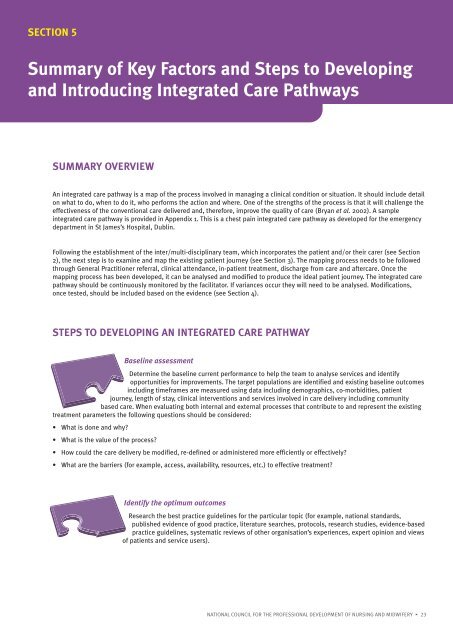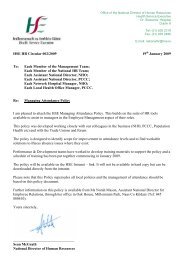Integrated Care Pathways - PNA
Integrated Care Pathways - PNA
Integrated Care Pathways - PNA
- No tags were found...
Create successful ePaper yourself
Turn your PDF publications into a flip-book with our unique Google optimized e-Paper software.
SECTION 5Summary of Key Factors and Steps to Developingand Introducing <strong>Integrated</strong> <strong>Care</strong> <strong>Pathways</strong>SUMMARY OVERVIEWAn integrated care pathway is a map of the process involved in managing a clinical condition or situation. It should include detailon what to do, when to do it, who performs the action and where. One of the strengths of the process is that it will challenge theeffectiveness of the conventional care delivered and, therefore, improve the quality of care (Bryan et al. 2002). A sampleintegrated care pathway is provided in Appendix 1. This is a chest pain integrated care pathway as developed for the emergencydepartment in St James’s Hospital, Dublin.Following the establishment of the inter/multi-disciplinary team, which incorporates the patient and/or their carer (see Section2), the next step is to examine and map the existing patient journey (see Section 3). The mapping process needs to be followedthrough General Practitioner referral, clinical attendance, in-patient treatment, discharge from care and aftercare. Once themapping process has been developed, it can be analysed and modified to produce the ideal patient journey. The integrated carepathway should be continuously monitored by the facilitator. If variances occur they will need to be analysed. Modifications,once tested, should be included based on the evidence (see Section 4).STEPS TO DEVELOPING AN INTEGRATED CARE PATHWAYBaseline assessmentDetermine the baseline current performance to help the team to analyse services and identifyopportunities for improvements. The target populations are identified and existing baseline outcomesincluding timeframes are measured using data including demographics, co-morbidities, patientjourney, length of stay, clinical interventions and services involved in care delivery including communitybased care. When evaluating both internal and external processes that contribute to and represent the existingtreatment parameters the following questions should be considered:• What is done and why?• What is the value of the process?• How could the care delivery be modified, re-defined or administered more efficiently or effectively?• What are the barriers (for example, access, availability, resources, etc.) to effective treatment?Identify the optimum outcomesResearch the best practice guidelines for the particular topic (for example, national standards,published evidence of good practice, literature searches, protocols, research studies, evidence-basedpractice guidelines, systematic reviews of other organisation’s experiences, expert opinion and viewsof patients and service users).NATIONAL COUNCIL FOR THE PROFESSIONAL DEVELOPMENT OF NURSING AND MIDWIFERY • 23













